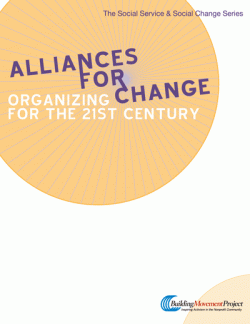Alliances for Change: Organizing for the 21st Century
The election of President Obama with his history and identification as a community organizer sent a message of hope and possibility to the community organizing world. For decades, community organizing groups in the U.S. grappled with the form and consequences of the state’s strike-back against hard won anti-poverty and civil rights gains of the 1960s. Privatization of state services led to an increasing reliance on nonprofit organizations to meet basic individual needs and to do more with less. In 2008 and beyond, organizing groups faced the community impact of the acute crisis of economy and ecology spurred at the global scale. At the same time, for those organizations engaging in critical analysis, reflecting on lessons learned, and developing new capacities at the grassroots, current political opportunities presented a demanding and urgent opening for re-visioning and shifting power. As a result, across the U.S., accelerated forms of community response began to take shape.
Workers’ centers, youth-based action groups, and urban justice organizations are among those who have changed the face of traditional community organizing. Many of these groups engage a range of approaches beyond targeted campaign work—from service delivery to media ownership to voter engagement. This report looks at nearly a dozen examples of organizing efforts rising to scale and adapting to the urgent challenges and political opportunities at the beginning of the 21st century. These groups reinforce grassroots democratic practices, achieve concrete wins, and build, sustain and connect diverse bases of power for long-term systemic change, all while creatively incorporating structures and programs that respond to the everyday needs of their participants.
Read a meeting summary from the convening in Woodburn, Oregon!

